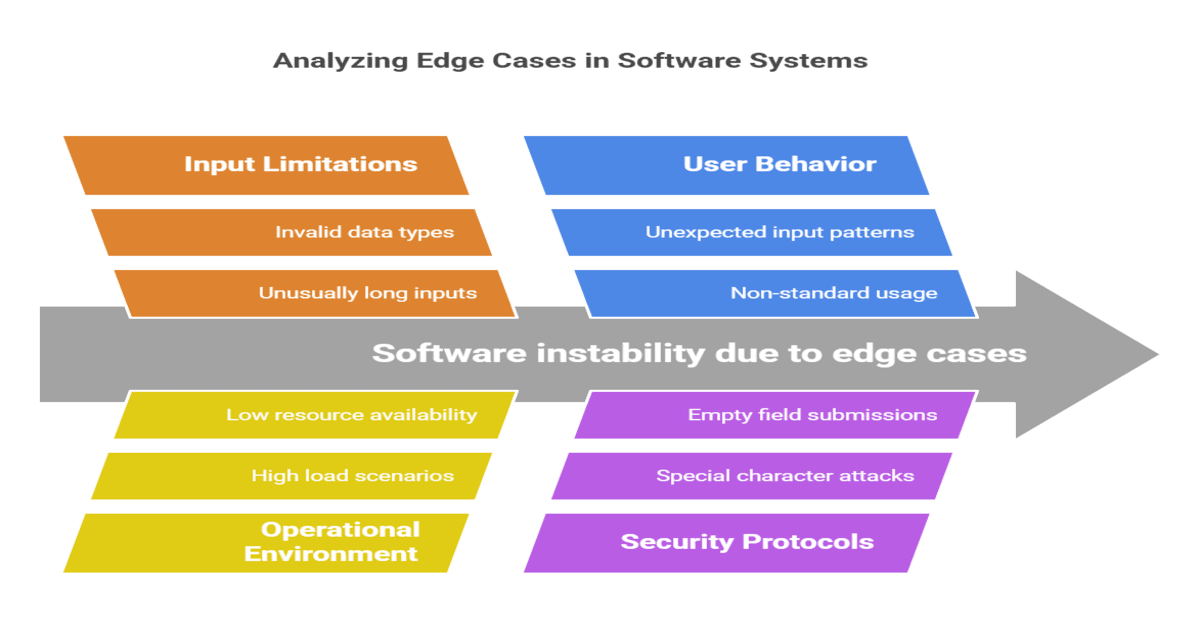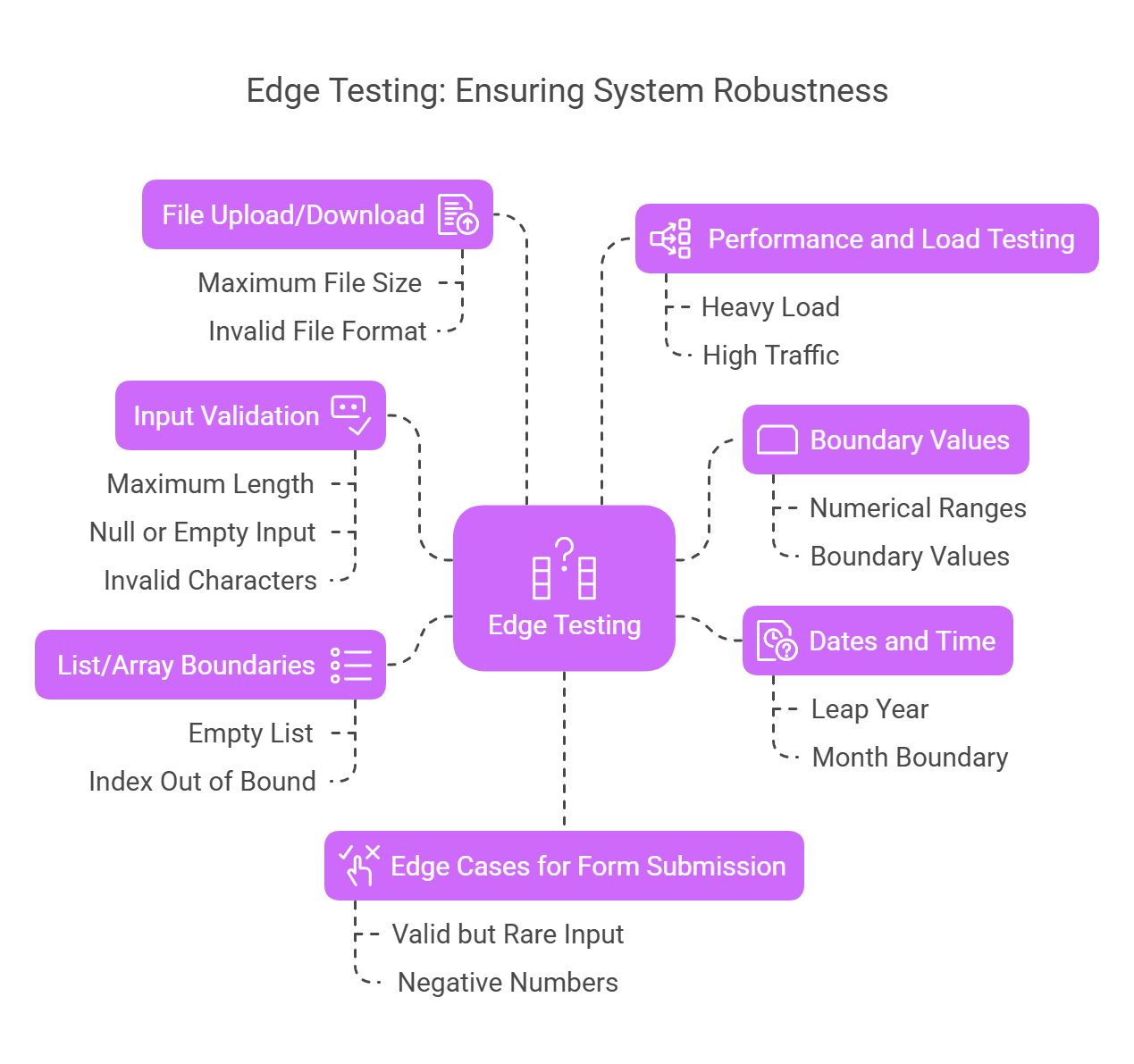Anyone can automate end-to-end tests!
Our AI Test Agent enables anyone who can read and write English to become an automation engineer in less than an hour.
Focusing solely on standard use cases can leave your application vulnerable to unexpected failures. Edge test cases address this by testing software behavior under unusual or extreme conditions outside typical operating scenarios.
Edge cases are scenarios that push the system to its operational limits or beyond, testing how it behaves under rare or extreme conditions. These cases, while infrequent, play a vital role in uncovering hidden vulnerabilities and ensuring your application remains stable and secure in all situations.
This guide explores what edge cases are, why they’re essential, and how to effectively write, identify, and prioritize them to enhance software reliability and user experience.

Edge cases are scenarios that test the system’s behavior at the boundaries or limits of its expected input or operational environment. They target extreme conditions that are unlikely but possible in real-world use cases. Identifying and testing these scenarios is crucial to ensure software stability and resilience under unexpected situations.
For example, if you’re developing a login page, you might face edge cases like an unusually long email address, a password with only special characters, or even an attempt to log in with an empty password field.
Edge test cases are designed to test the boundaries or extreme values of input data. These test cases help ensure that the system behaves as expected in unusual or extreme conditions. Here are some examples:

If an input field accepts a string, test with the maximum number of characters allowed (e.g., if the max length is 50, test with exactly 50 characters).
Test with the shortest input, such as an empty string or a string with only one character.
Provide an empty input (e.g., null, or an empty string "").
Input special characters, like @, #, or non-ASCII characters if the input is expected to be alphanumeric.
If the system expects a number in a certain range, test with values just below, within, and just above the range. For example, for a system that accepts numbers from 1 to 100:
Test with 0 (below the range).
Test with 1 (lower boundary).
Test with 100 (upper boundary).
Test with 101 (above the range).
Test with a date on a leap year, such as February 29th.
Test with the last day of the month and the first day of the next month (e.g., January 31st and February 1st).
Test with a boundary between years, like December 31st and January 1st.
Test with a non-existent date, such as February 30th.
If the system expects a list of items, test with an empty list.
Test with a list containing a single item.
Test with the maximum number of items allowed in the list or array.
Try accessing an element at an invalid index (e.g., an index that’s greater than the list size).
Upload a file that is exactly at the maximum allowed size.
Upload an empty file or one with no content.
Upload a file with an unsupported format.
Test with a large number of simultaneous users or a large volume of data to see if the system can handle it.
Test with requests arriving at a very high frequency to evaluate the system’s scalability.
Test with values that are valid but infrequent, like a very long name, unusual punctuation, or a name with international characters.
If the system expects only positive numbers, test with negative numbers to see if it handles them gracefully.
Edge test cases often uncover flaws that wouldn’t surface in normal use cases. For instance, a user uploading a file that exceeds the maximum size limit could crash the application if not handled properly.
Unexpected crashes or errors disrupt the user journey. Testing edge cases helps in creating a smooth and frustration-free experience by preemptively addressing these issues.
In sectors like healthcare or finance, a minor oversight can result in significant harm. Properly tested edge cases increase the reliability of your software in critical applications.
Writing effective edge test cases requires a keen understanding of the system's operational limits. Here are some steps to guide you through the process:
Determine the boundaries and constraints of the system.
Design test scenarios that push the software beyond these boundaries.
Clearly define what the system should do in each case.
Focus on edge cases that impact user experience, legal compliance, or safety.
Continuously review your test cases based on feedback and results.
Not all edge cases need to be tested or fixed. Here’s how you can prioritize effectively:
Evaluate the potential impact on the user experience.
Consider edge cases that could affect safety or regulatory compliance.
Identify the likelihood of each edge case happening.
Determine the difficulty and resources required to address the edge cases.
Automation tools can help streamline the testing of edge cases. By scripting repeatable and controlled inputs, automation enables efficient testing of extreme scenarios that would otherwise be labor-intensive and prone to human error.
Popular Automation Tools
Ideal for web applications.
Great for mobile applications.
Excellent for handling web, mobile, and API testing with codeless automation.
For testing website BFSI (Banking, Financial Services, and Insurance) website (as example to understand edge cases better!), edge test cases are crucial for ensuring that the system functions correctly under extreme or unusual conditions. Here are some edge cases you might consider:
Test with incorrect username and password combinations, including:
Non-existent username.
Incorrect password for a valid username.
Case-sensitive username/password.
Test the behavior when a user exceeds the maximum number of login attempts.
Test how the system handles session expiry (e.g., automatically logging out after a period of inactivity).
Attempt to log in from different devices/browsers simultaneously and check the system's behavior.
Test with the minimum and maximum valid length for an account number.
Test with special characters like #, $, or *.
Test with an invalid account number that’s too short or too long.
Test with boundary values like 0, minimum, and maximum transaction amounts.
Test negative amounts or zero.
Test a large amount, such as the maximum allowed by the system, to check how it handles large transactions (e.g., large wire transfer).
Test with the correct and incorrect PIN lengths.
Test with valid but unexpected values, such as sequential digits (1234) or identical digits (1111).
Test with a valid card number but an expired date.
Test with a valid card number but incorrect CVV.
Test with an invalid card number (e.g., non-existent).
Test with currency conversion at the minimum and maximum conversion limits.
Test with an unsupported or invalid currency.
Test with payments made from a different country (testing for exchange rates, country-specific rules).
Test payments with different methods (credit card, bank transfer, wallet) simultaneously.
Test for SQL injection vulnerabilities by attempting to inject SQL queries into input fields like search or login.
Test with script injections in form fields, such as < script > alert('xss') < /script >.
Test if the session token persists across multiple pages or if logging out invalidates the session properly.
Test if sensitive data, such as passwords, is transmitted securely over HTTPS (check for SSL certificate expiration).
Test if sensitive information (account balance, transaction history) is encrypted in storage and transmission.
Test fields with the maximum allowable characters (e.g., names, email addresses, address fields).
Test for names with special characters such as hyphens (-), apostrophes ('), and spaces.
Test with unusually long addresses, address components with special characters, and empty address fields.
TTest with future dates or invalid dates like February 30th or 31st in months that don't have 31 days.
Test how the website adjusts to different screen sizes, including smartphones, tablets, and desktop browsers.
Test if the website’s touch controls (for mobile devices) are responsive and functional.
Test if the system can handle multiple simultaneous transactions (e.g., multiple people transferring funds or making payments at the same time).
Test with large amounts of transaction history (e.g., displaying thousands of transactions).
Test with empty or no transaction history for a user.
Test if a user can deposit a cheque image with varying file formats, sizes, and resolution quality.
Test loan applications with edge-case scenarios such as a very high loan amount, very low credit score, or invalid personal data.
Test the updating of account details with boundary values for fields like name, address, and phone number.
Test password change functionality by using:
Invalid old password.
New passwords that are too short, too long, or contain special characters.
A password that is the same as the previous one.
Test how the website handles deactivation or deletion requests, ensuring the account is fully removed and cannot be accessed again.
Test with invalid inputs or missing fields (e.g., leaving required fields blank).
Test how the website handles broken links or missing pages (e.g., when users enter a non-existent URL).
Test how the system behaves when operations take too long, e.g., when transferring large amounts or processing payments.
Test how the system handles API failures or slow responses, especially in financial transactions.
Test for edge cases in notification delivery, like invalid email addresses, full inboxes, or international numbers.
Test push notifications across various devices and browsers to ensure they function correctly.
Test the website on different browsers (Chrome, Firefox, Edge, Safari, etc.) and ensure functionality is consistent.
Test on different mobile browsers (e.g., Chrome on Android, Safari on iOS) for consistent behavior.
Identifying defects in edge test cases involves a systematic approach to testing scenarios at the boundaries of a system’s functionality. Here are key techniques to help you identify these defects effectively:
Begin by thoroughly reviewing requirements to define the system's operational boundaries, such as maximum field lengths, input constraints, and valid data types.
Test inputs at and just beyond the boundaries. For example, if a field accepts 1-100 characters, test with 0, 1, 100, and 101 characters to find defects.
Divide input data into valid and invalid classes. Test one value from each class to cover various scenarios, including edge cases outside normal parameters.
Think from a user’s perspective and create edge case scenarios based on unusual sequences, like trying to log in with expired sessions or submitting unsupported characters.
Simulate high loads or extreme inputs to check system performance under stress, like multiple concurrent logins or oversized file uploads.
Automate repetitive edge test cases with tools like Selenium to ensure consistency and catch defects that manual testing might miss.
Conduct beta testing and gather insights from real-world users to uncover overlooked edge scenarios.
By using these methods, you can effectively identify edge case defects, ensuring your system is resilient and performs reliably under all conditions.
To give you a better idea, here are some examples of common edge test cases:
Testing fields with maximum and minimum allowed characters and special character combinations.
Uploading files with various formats, sizes, and names.
Simulating multiple users performing simultaneous operations on the system.
Inputting values beyond the typical range, such as negative numbers or excessively large figures.
Edge test cases focus on testing the login page's response to unusual or extreme scenarios to ensure robustness and security. Key examples include:
Test login attempts with empty inputs to trigger error messages.
Validate the system’s handling of overly long usernames or passwords.
Check for security vulnerabilities by testing common SQL injection inputs.
Ensure passwords with only special characters are correctly handled.
Validate against email addresses exceeding standard limits.
Confirm input is trimmed to avoid incorrect login attempts.
Test logins with expired passwords and check for prompts to update.
Verify account lockout after consecutive failed attempts.
Ensure consistent functionality across various browsers and devices.
Check handling of idle login pages to enforce security.
These edge test cases help ensure a secure, user-friendly, and reliable login experience.
Consider how users might inadvertently interact with the software.
Plan for unanticipated conditions like server timeouts, network issues, or extreme hardware variations.
Collaborate with developers, designers, and stakeholders to get a holistic view of possible edge cases.
Incorporating edge test cases into your testing strategy is more than just a proactive measure—it’s a necessity for delivering a high-quality software product. These tests prepare your application to handle rare, unexpected scenarios, ensuring it remains secure, resilient, and user-friendly. Paying attention to edge case testing could be the key to avoiding critical issues and maintaining user trust in your product.
Common edge cases include empty fields, maximum or minimum input values, special characters, and invalid file formats.
An edge use case tests software behavior at its limits or unusual conditions to assess reliability.
It's called an "edge case" because it tests scenarios at the boundaries or extremes of normal behavior.
"Edge" in testing ensures software can handle unexpected inputs and extreme situations reliably.
Written by

PRAMIN PRADEEP
With over 8 years of combined experience in various fields, Pramin have experience managing AI-based products and have 4+ years of experience in the SAAS industry. Pramin have played a key role in transitioning products to scalable solutions and adopting a product-led growth model. He have experience with B2B business models and bring knowledge in new product development, customer development, continuous discovery, market research, and both enterprise and self-serve models.
Our AI Test Agent enables anyone who can read and write English to become an automation engineer in less than an hour.